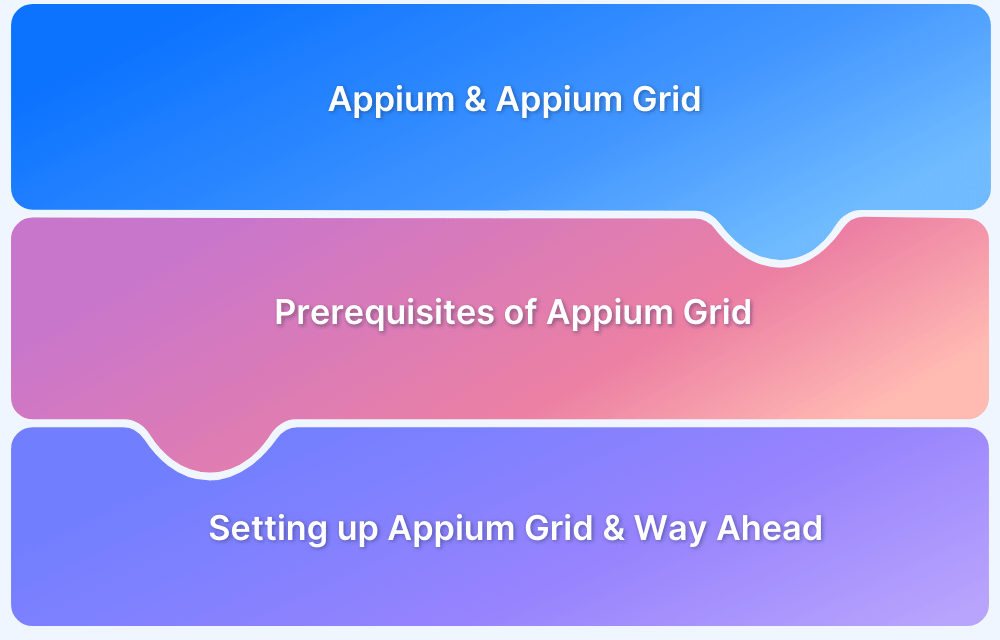I used to think most Appium test failures came from device instability or OS issues.
But after analyzing dozens of projects, I found that over 70% of failures were caused by how we wrote and structured our tests—not the tools.
That’s when it became clear: Appium isn’t unreliable—our approach is.
Once we started using the right locators, adopting Page Object Model, running on real devices, applying smart waits, enabling parallelization, and tracking Appium logs, our reliability and execution speed improved dramatically.
Overview
Best Practices for Appium Testing
- Parallelization
- Use the Right Locators
- Use Page Object Model
- Run Tests on Real Devices
- Use Wait
- Use Appium Logs
In this blog, I’ll walk you through these core best practices that turn Appium from flaky to fast, scalable, and production-ready.
Best Practices: Testing with Appium
The following Appium best practices strengthen mobile automation by improving stability, reducing flaky behavior, and ensuring reliable execution across Android and iOS environments.
Parallelization
Parallel test execution increases test throughput and exposes device-specific issues earlier.
Significance:
Running Appium tests sequentially slows feedback cycles and hides platform variations. Parallelization distributes tests across multiple devices, operating systems, and versions, reducing bottlenecks and surfacing inconsistencies in UI behavior. It is especially useful for regression test cycles where execution time directly affects release velocity.
Apply in real user scenarios like:
- A team needs to validate checkout flows across three Android devices and two iPhones before a production push and cannot wait several hours for sequential runs.
- A CI pipeline triggers dozens of smoke tests on every commit; parallel threads prevent queue backlogs and ensure engineers get quick results.
- A product team supports older OS versions; running tests in parallel highlights visual or timing regressions specific to certain builds.
Read More: How to Setup an Effective CI/CD Pipeline
Use the Right Locators
Choosing correct and stable locators prevents UI flaky tests and reduces maintenance.
Significance:
Poor locator strategies often cause intermittent failures when UI elements shift, animate, or render differently across devices. Prioritizing accessibility IDs, resource IDs, or stable attributes ensures selectors remain reliable even when layout or styling changes. This reduces the need for frequent script updates.
Apply this best practices in real user scenarios like:
- A login button uses a dynamic index value on certain devices; tests break whenever the screen layout changes.
- A developer modifies view hierarchy during a UI refresh, causing XPath-based selectors to fail across Android models.
- A QA team encounters false negatives because multiple similar elements match the same locator during onboarding flows.
Jonathan Lipps – former architect and contributor of the Appium Project and mobile automation expert, explains that most flaky Appium tests stem from synchronization issues and brittle selectors rather than the framework itself.
Use Page Object Model
POM increases code readability and centralizes UI logic for repeatable tests.
Significance:
Page Object Model (POM) separates locators and interaction logic from test cases, making automation scalable and easier to maintain. Any UI change is updated in a single place, preventing redundant edits across test files. It also supports cleaner test scripts that focus on intent rather than low-level UI operations.
Apply this best practices in real user scenarios like:
- A payment screen changes field names; without POM, dozens of test files require manual update.
- Multiple teams contribute to the same Appium test suite; POM ensures consistency in locator usage and reduces merge conflicts.
- New testers onboarding quickly understand page structures without deciphering scattered element definitions.
Run Tests on Real Devices
Testing on physical devices ensures accurate validation of performance and user behavior.
Significance:
Emulators and simulators are helpful in early development, but they cannot fully represent hardware-driven interactions, GPU rendering, battery constraints, sensor inputs, or OEM-specific quirks. Real device testing uncovers issues that synthetic environments fail to surface.
Apply this best practices in real user scenarios like:
- A gesture-heavy screen scrolls smoothly on an emulator but stutters on mid-range Android hardware due to GPU throttling.
- A camera permission prompt behaves differently on Samsung devices, causing tests to hang during image upload workflows.
- A biometric login feature works on an iOS simulator but needs real-device hardware triggers for proper validation.
BrowserStack App Automate enables teams to run stable Appium tests on real devices at scale, helping catch locator, performance, and OS-specific issues early in the testing cycle.
Use Wait
Proper waits prevent flakiness caused by asynchronous rendering or network delays.
Significance:
Mobile apps often load data progressively, animate transitions, or display dynamic elements. Hard-coded sleeps introduce unpredictability and slow the suite. Explicit waits tied to element states, activity transitions, or network conditions ensure interactions occur at the correct moment.
Refer to Appium Timeouts documentation here.
Apply this best practices in real user scenarios like:
- A product list API call takes longer on certain network routes; tests fail because elements are not yet visible.
- A multi-step onboarding animation runs at different speeds on iOS and Android, causing inconsistent tap timing.
- A modal appears after a delayed permission check; without proper waits, the script attempts to interact with underlying elements.
Use Appium Logs
Clear logs accelerate debugging and help trace root causes of unexpected failures.
Significance:
Appium server logs contain detailed information about session creation, commands, responses, capabilities, and element interactions. Reviewing these logs helps pinpoint locator errors, capability misconfiguration, or timing mismatches. Logs also offer visibility into device behavior during complex flows.
Apply this best practices in real user scenarios like:
- A script intermittently fails when launching the app; server logs show an incorrect package/activity configuration on Android.
- An iOS test stops responding during a deep navigation flow; logs reveal repeated element search failures caused by a stale hierarchy.
- A CI job shows inconsistent app launch timing; logs highlight delays triggered by background OS processes.
Keep Code Modular
Structuring tests into reusable components improves maintainability and reduces duplication across workflows.
Significance:
Mobile test suites grow quickly as features expand. Without modular design, shared flows—such as login, navigation, or API setup—get duplicated across multiple tests, increasing maintenance effort when changes occur. Modular architecture separates concerns into helper methods, utilities, configuration files, and reusable business-level actions, making updates faster and reducing the chance of inconsistent behavior across tests.
Apply in real user scenarios like:
- A login workflow is used in 40+ test cases; a UI update to the login button requires modifying only one shared method instead of fixing every test individually.
- A payment flow reused across checkout, subscriptions, and add-ons changes its security step; modular utilities ensure the new step is updated once and applied everywhere.
- Multiple teams contribute to the same test suite; shared, modular components prevent conflicting logic and ensure uniform interaction patterns.
Read More: Appium Visual Testing: The Essential Guide
Use Consistent Naming Conventions
Clear and predictable naming helps teams navigate large codebases and understand test intent quickly.
Significance:
Mobile automation suites often include hundreds of test scripts, page classes, helper utilities, and element locators. Inconsistent naming slows onboarding, increases confusion, and leads to accidental duplication. Consistent naming conventions create an organized structure where tests, variables, and methods are easy to interpret, reducing errors during updates or reviews.
Apply in real user scenarios like:
- A tester joins a project mid-cycle and can immediately understand methods like tapLoginButton() or enterEmailAddress() because they follow a standard format.
- Locators named inconsistently across pages lead to accidental reuse of outdated identifiers; consistent naming eliminates ambiguity and ensures accurate updates.
- CI failures are easier to diagnose when test names clearly represent workflows, such as test_add_item_to_cart or test_update_profile_picture.
Read More: Understanding FindElements in Appium
Leverage Version Control
Storing the automation framework in version control enables collaboration, traceability, and safe iteration.
Significance:
Mobile test automation evolves with frequent code updates, device variations, and feature changes. Version control systems like Git ensure every modification is tracked, reviewed, and reversible. This prevents accidental overwrites, supports parallel development, and helps teams experiment safely without impacting stable test branches.
Apply in real user scenarios like:
- A script update breaks multiple flows; version history allows teams to revert to a stable commit instantly.
- Two testers working on similar modules create a merge conflict; version control helps detect and resolve inconsistencies early.
- Feature-specific test branches enable isolated development until a new feature is ready to merge into the main suite.
Refer this documentation on how to set Appium version in your test
Manage App State Efficiently
Controlling reset behaviors improves execution speed and ensures tests start from predictable states.
Significance:
Reinstalling the app or clearing data for every test run increases execution time unnecessarily. Using noReset=true or fullReset=false allows tests to resume from a signed-in or configured state, reducing setup steps and improving reliability for workflows that require consistent app data or user sessions.
Apply in real user scenarios like:
- A sign-in flow requires OTP verification; setting noReset=true preserves the authenticated state so subsequent tests skip redundant login steps.
- A shopping app needs the cart pre-populated for specific test paths; a controlled reset strategy ensures the cart remains intact between tests.
- A mobile banking app test suite runs faster when onboarding screens are disabled after the first run, thanks to preserved application state.
Why choose BrowserStack for running Appium Tests?
Appium needs to be tested on real devices because emulators and simulators fail to capture real-world factors like hardware behavior, OS interruptions, network conditions, and actual user gestures. Running tests on physical devices ensures Appium automation reflects how the app behaves in production and prevents issues that virtual environments often miss.
BrowserStack App Automate is a cloud-based mobile app testing platform designed to run automated tests on real iOS and Android devices at scale.
It provides instant access to thousands of device–OS combinations, supports native and hybrid app testing workflows, and removes the operational overhead of maintaining physical device labs. Teams can execute tests directly from CI pipelines, gather rich debugging insights, and validate real-world user conditions faster and more reliably.
Why BrowserStack App Automate is Best Suited for Appium Testing:
- Large real-device cloud covering thousands of Android and iOS device–OS combinations, enabling accurate testing of hardware behaviors, OEM variations, sensors, camera workflows, and performance constraints.
- Quick onboarding with the BrowserStack SDK, allowing Appium tests to run within minutes without changing existing code or rewriting capabilities.
- Parallel test execution across multiple devices to drastically reduce test cycle times and speed up CI/CD pipelines.
- In-depth debugging with text logs, console logs, network logs, performance metrics, and video recordings for every Appium session.
- Access to Private Devices for high-security testing or custom configuration needs, ensuring consistent and compliant test environments.
- AI-driven enhancements such as self-healing locators, automated failure analysis, intelligent test selection, and cross-device automation that improve stability and reduce maintenance efforts.
These capabilities make App Automate a powerful, scalable, and production-ready environment for teams relying on Appium to test mobile apps with real-world accuracy and fast feedback loops.
Conclusion
Appium is an automation framework which helps testers identify bugs early in the development cycle and reduces manual testing efforts. In order to get the best out of this testing framework, one must put the best practices mentioned above to use. These practices offer guidance to make mobile automation testing more effective and reliable.
Useful Resources for Appium
Tutorials
- How to perform Parallel Test Execution in Appium?
- Appium Visual Testing: The Essential Guide
- How to run Appium iOS Tests on Real Devices?
- How to perform Debugging in Appium
- How to Run Your First Appium Test Script
- How to report bugs in Appium UI Testing?
- How to run Appium Tests on macOS?
- XPath in Appium: Tutorial
- How to Analyze Appium Logs
- How to perform Drag and Drop using Appium
- How to test mobile app in Landscape or Portrait mode using Appium
- How to Run Same Script in Multiple Devices using Appium
- How to change Time Zones for Mobile App Testing using Appium
- How to Perform Localization of Mobile Apps using Appium
- What is Appium Inspector? (Benefits & How to Use it?)
- How to run Appium tests on Android devices
- How to scroll down to an element in Appium
- How to Download and Install Appium
- How to set up your Appium Grid
- How to test Biometric authentication using Appium?
- How to use touch actions in Appium?
- How to Automate a Real E2E User Flow involving App and Browser with Appium
- How to Inspect Element using UIAutomatorViewer in Appium
- How to Test Flutter Apps Using Appium Automation
- Understanding Appium Desktop: Tutorial
- Appium Tutorial for Mobile Application Testing
- React Native and Appium Tutorial
- Understanding FindElements in Appium
Best Practices, Tips, and Tricks
- Appium Best Practices Every Developer Must Know
- Effective Locator Strategies in Appium
- Top Appium Commands every Developer must know
- Desired Capabilities in Appium
- Overcoming Top Challenges faced in Appium Automation
Getting Started with
- Getting Started with Appium and NUnit framework
- WebdriverIO Tutorial: Getting started with Test Automation using Selenium and Appium
- Appium with Python: Getting Started with App Automation Testing
- Appium with Java: Getting Started to Run Automated Tests
- Test Windows Desktop App using Appium-Compatible WinAppDriver
Differences and Comparisons






